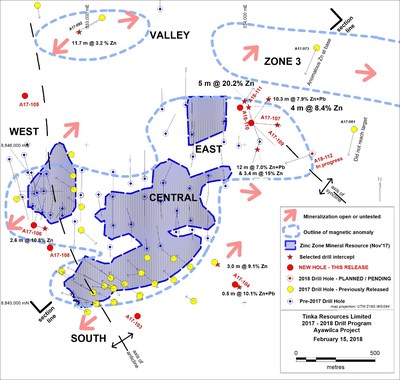
Tinka drills 5 metres grading 20 % zinc at Zone 3, Ayawilca project
PR Newswire
VANCOUVER, Feb. 15, 2018
VANCOUVER, Feb. 15, 2018 /PRNewswire/ - Tinka Resources Limited ("Tinka" or the "Company") (TSXV & BVL: TK) (OTCPK: TKRFF) is pleased to announce assay results for a further nine drill holes from the Company's ongoing drill program at its 100%-owned Ayawilca zinc project, central Peru. All holes were testing for mineralization outside of the existing mineral resource boundaries (Ayawilca Inferred Mineral Resource estimate: 42.7 million tonnes grading 6.0% Zn, 0.2% lead, 17 g/t silver and 79 g/t indium; Nov 8, 2017). Four holes (107, 109, 110 and 111) were drilled at the new Zone 3 discovery area, part of a large geophysical target believed to be the northeastern extension of Ayawilca. An additional five holes were drilled at South, West and Central Ayawilca. Drilling of hole A18-112 at Zone 3 has now commenced, with a second drill rig expected to start up once the wet weather conditions improve in March.
High-grade zinc mineralization intersected in holes A18-110 & A18-111 at Zone 3 is associated with flat-dipping massive sulphide replacements of the Pucará limestone and lower Goyllar sandstone, similar in style to the zinc mineralization at South and West Ayawilca. In addition, high-grade vein-style polymetallic mineralization (zinc-lead-silver-tin) has been intersected in phyllite rocks at Zone 3 (hole A17-109), which represents a new style of mineralization encountered at Ayawilca for the first time. The high-grade polymetallic veins are believed to be feeder structures for the zinc and tin mineralization in the overlying limestones.
Key Highlights
Massive sulphide drill intercepts#
Hole A18-111 (Zone 3):
- 5.0 metres at 20.2 % zinc, 0.3 % lead, 74 g/t silver & 420 g/t indium from 173.8 metres depth.
Hole A18-110 (Zone 3):
- 6.0 metres at 5.6 % zinc & 50 g/t indium from 436.0 metres depth; and
- 4.0 metres at 8.4 % zinc & 126 g/t indium from 454.0 metres depth, including
- 0.5 metres at 41.7 % zinc & 366 g/t indium from 456.2 metres depth; and
Hole A17-107 (Zone 3):
- 16.0 metres at 0.65 % tin & 0.09 % copper from 576.0 metres depth, including
- 2.8 metres at 2.4 % tin & 0.01 % copper from 582.5 metres depth.
High-grade polymetallic veins*
Hole A17-109 (Zone 3):
- 0.7 metres at 4.8 % zinc, 8.8 % lead, 674 g/t silver & 0.76 % tin from 577.0 metres depth; and
- 1.2 metres at 5.2 % zinc, 10.1 % lead, 621 g/t silver & 0.29 % tin from 611.2 metres depth; and
- 0.6 metres at 5.5 % zinc, 4.8 % lead, 305 g/t silver & 0.48 % tin from 615.4 metres depth; and
- 0.35 metres at 6.5% zinc, 9.0 % lead, 557 g/t silver & 0.76 % tin from 681.6 metres depth.
Hole A18-110 (Zone 3):
- 0.35 metres at 17.1 % zinc, 7.5 % lead, 1.15% copper & 513 g/t silver from 530.4 metres depth.
# True thicknesses of the zinc and tin intersections in massive sulphides are estimated to be at least 85% of the downhole thicknesses.
* True thicknesses of the veins are unknown at this time.
Dr. Graham Carman, Tinka´s President and CEO, stated: "The discovery of high grade mineralization in limestones and in deep veins at Zone 3 is very exciting, as it opens up a lot more exploration potential at the project. It is still early days for the exploration at Zone 3, it is a large target area with only a handful of holes drilled so far and with several geophysical anomalies untested (see drill map, Figure 1). Other priority targets for this year include extensions of the mineralization at West, South, and Central Ayawilca. A new geological interpretation suggests that high-grade, thick zinc mineralization generally lies near the intersection points of northeast-trending faults and north-south trending folds in the strata. Tinka plans to drill an additional 25 to 30 step-out holes into a range of targets during the first half of 2018."
Dr. Carman continued: "The Company has two key objectives for 2018: (1) Continue our exploration drill program targeting additional zinc resources at Ayawilca with 15,000 metres of drilling planned; and (2) Advance the project with desktop mining studies and detailed metallurgical tests that will form the basis of a Preliminary Economic Assessment ("PEA") planned for the second half of 2018. Exact timing of the PEA will depend on the extent to which significant new mineralization is identified in the first half of 2018.
The strong backdrop for zinc remains, with zinc prices close to 11-year highs while inventories are reaching critically low levels not seen since 2008. In particular, there remains a shortage of large high-grade exploration-development projects for zinc in good mining jurisdictions, like Ayawilca, in the marketplace."
Geological review and new interpretations
A recent geological review of drill cores by Tinka's geologists, with input from consultant Dr. Paul Pearson of Latin Global Pty Ltd, has led to some new interpretations of the structural controls to the mineralization at Ayawilca. We believe that the lower contact of the Mesozoic Pucará limestone, the principal host to the zinc mineralization at Ayawilca, is a low-angle 'thrust' fault that can be traced over several kilometres and dips to the east, in contact with underlying phyllite basement rocks.
At South Ayawilca, multiple thrust fault 'duplexes' or ramps have caused repetitions of the limestone/sandstone, while at the far western end of South Ayawilca the limestone is almost 'faulted out' altogether. The low-angle faults are believed to have acted as conduits for the mineralization, with the ultimate source of the mineralization believed to be down-dip to the northeast towards Zone 3 (see longitudinal section, Figure 2). Fluids migrating along these low-angle faults mineralized the limestone sequence, while at South and West Ayawilca mineralization was 'trapped' near the axis of the anticline+ fold where the limestone rapidly thins. The syncline+ at Zone 3 may also be an important trap site for mineralization, with upcoming drilling to test this structure. Faulting was pre-mineral, but was important because it created good ground preparation for the mineralizing fluids to follow, particularly where the faults intersect fold hinges, such as the anticline at South Ayawilca or potentially the syncline at Zone 3 (Figures 1 and 2).
Drilling at Zone 3 has also encountered significant intervals of pyrite mineralization near the bottom of the limestones, which further strengthens the similarities in mineralization styles between Ayawilca and the Cerro de Pasco lead-zinc-silver-copper deposit, located 40 kilometres southeast of Ayawilca.
The evolving understanding of the structural controls and likely reasons for the formation of thick zones of high grade zinc mineralization, such as at South and West Ayawilca, will aid in the selection of additional drill targets for 2018.
True thicknesses of the zinc and tin intersections are estimated to be at least 85% of the downhole thickness, except in the case of polymetallic veins which have unknown true thicknesses. Significant new drill intercepts are summarized in Table 1 with the strongest intercepts in bold text. Table 2 summarizes the drill collar information for the recent holes.
Notes on sampling and assaying
Drill holes are diamond HQ or NQ size core holes with recoveries generally above 80% and often close to 100%. The drill core is marked up, logged, and photographed on site. The cores are cut in half at the Company's core storage facility, with half-cores stored as a future reference. Half-core is bagged on average over 1 to 2 metre composite intervals and sent to SGS laboratories in Lima for assay in batches. Standards and blanks are inserted into each batch prior to departure from Tinka's core storage facilities. At the laboratory samples are dried, crushed to 100% passing 2mm, then 500 grams pulverized for multi-element analysis by ICP using multi-acid digestion. Samples assaying over 1% zinc, lead, or copper and over 100 g/t silver are re-assayed using precise ore-grade AAS techniques.
Samples which assay approximately 200 ppm tin or greater in the ICP analysis are re-assayed for tin by fusion with sodium peroxide and AAS finish (SGS Lima laboratory method SGS-AAS90B).
+ An "anticline" is a geological structure whereby the strata are folded into an upside down 'U'. A "syncline" is the opposite with strata folded in an 'U' shape.


Table 1. Significant new intercepts at Ayawilca in 2017-2018 drill program
| | | | | | | | | | | | |
| Drill hole | From | To m | Interval | Zinc | Lead | Silver | Indium | Tin | Copper | Area | Reported |
| A17-103 | no significant results | South | Here | ||||||||
| A17-104 | 289.50 | 290.00 | 0.50 | 5.9 | 4.2 | 104 | 0 | | | South-Central | Here |
| | 459.50 | 460.90 | 1.40 | | | 51 | | 0.55 | 0.04 | South | Here |
| A17-105 | 93.00 | 94.00 | 1.00 | 2.8 | 6.1 | 184 | 1 | | | West | Here |
| A17-106 | 288.00 | 290.60 | 2.60 | 10.8 | 2.2 | 114 | 0 | | | West | Here |
| including | 289.40 | 290.60 | 1.20 | 20.8 | 4.3 | 217 | 0 | | | West | Here |
| A17-107 | 576.00 | 592.00 | 16.00 | | | 2 | | 0.65 | 0.09 Werbung Mehr Nachrichten zur Tinka Resources Aktie kostenlos abonnieren
E-Mail-Adresse
Bitte überprüfe deine die E-Mail-Adresse.
Benachrichtigungen von ARIVA.DE (Mit der Bestellung akzeptierst du die Datenschutzhinweise) -1  Vielen Dank, dass du dich für unseren Newsletter angemeldet hast. Du erhältst in Kürze eine E-Mail mit einem Aktivierungslink. Hinweis: ARIVA.DE veröffentlicht in dieser Rubrik Analysen, Kolumnen und Nachrichten aus verschiedenen Quellen. Die ARIVA.DE AG ist nicht verantwortlich für Inhalte, die erkennbar von Dritten in den „News“-Bereich dieser Webseite eingestellt worden sind, und macht sich diese nicht zu Eigen. Diese Inhalte sind insbesondere durch eine entsprechende „von“-Kennzeichnung unterhalb der Artikelüberschrift und/oder durch den Link „Um den vollständigen Artikel zu lesen, klicken Sie bitte hier.“ erkennbar; verantwortlich für diese Inhalte ist allein der genannte Dritte. Andere Nutzer interessierten sich auch für folgende News | ||



